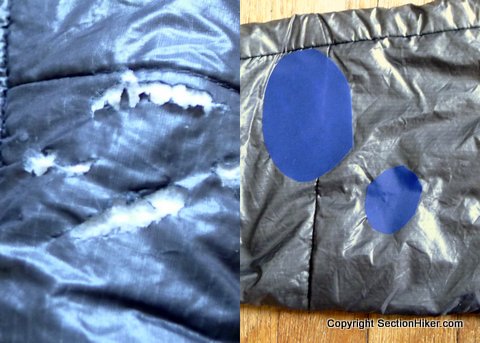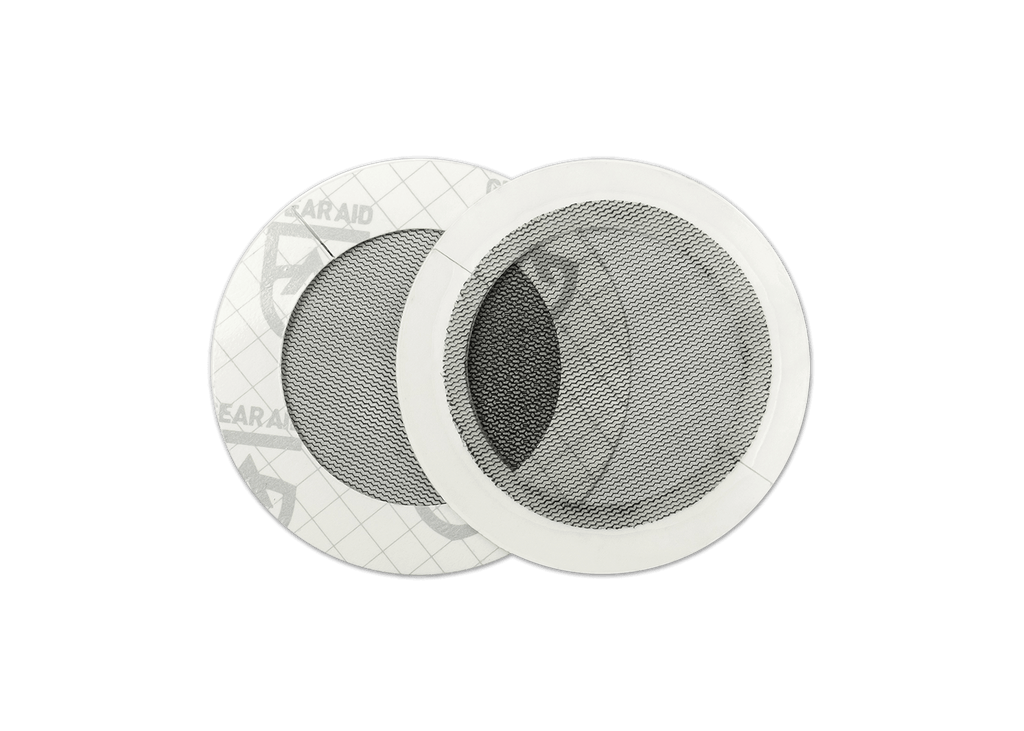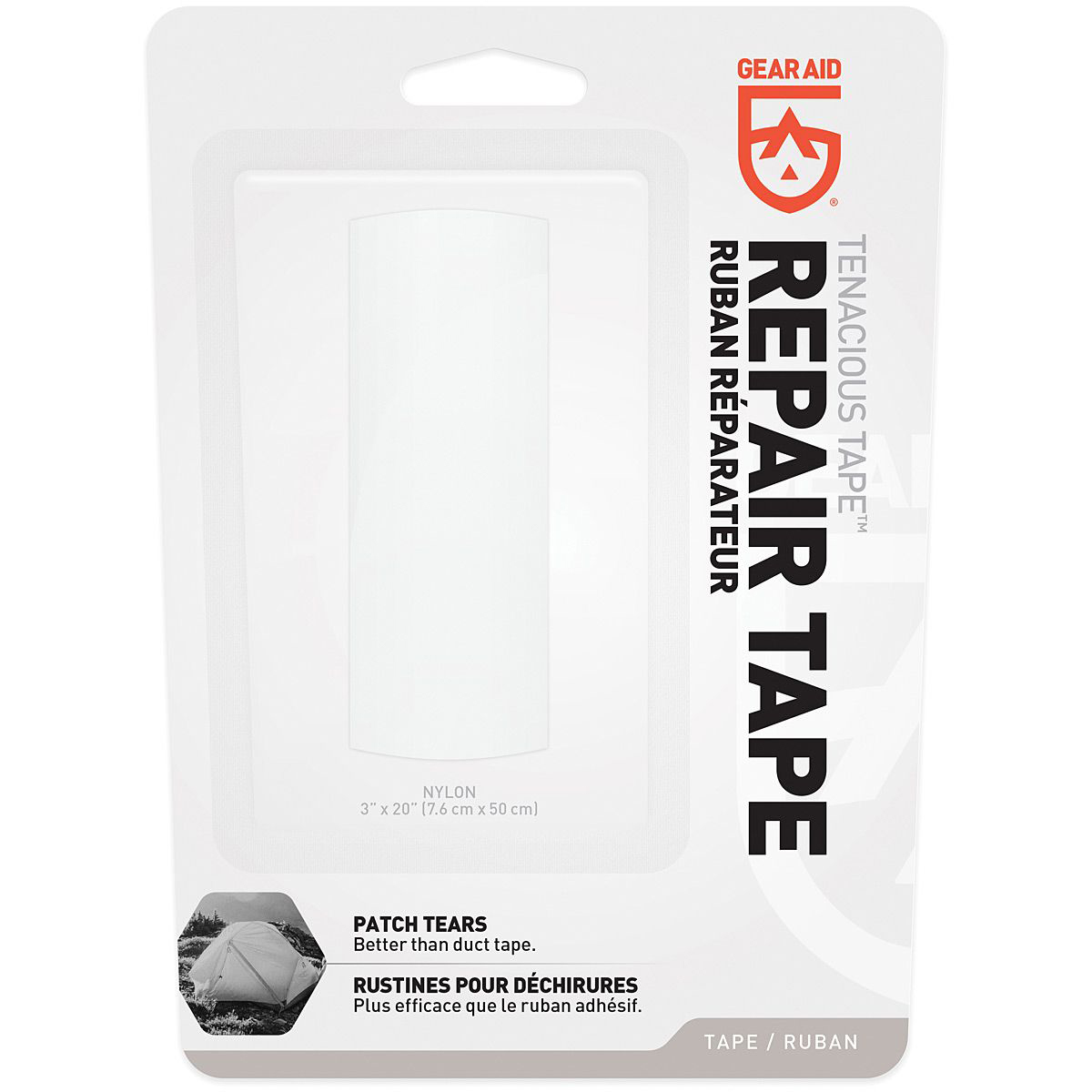Tenacious Tape is the bee’s knees for patching rips and burns in hard shells and insulated jackets, inflatable sleeping pads, tents, sleeping bags, and backpacks. I’ve used it many times since to repair the gear and clothing I like and want to keep using.
Tenacious Tape comes in two forms: as a bulk (20″ x 3″) roll or in 3″ pre-cut circles ( four x 3″ circles) that are easy to slide into your gear repair kit. The pre-cut circles are less of a price rip off than you might imagine and I prefer to carry them for field use, while I use a Tenacious Tape roll for repairs I do at home.
Before you apply Tenacious tape, it’s best to round the corners of a patch with a pair of scissors to reduce the chance that a corner of the patch will get caught and torn off. (You do the same thing when you cover a blister with tape.) Carrying the pre-cut patches means you don’t have to bring a pair of scissors with you when you’re hiking. Cutting a patch from the roll also takes a lot more prep work and creates waste that you need to pack out if you prepare a patch in the field.

For example, here’s a before and after shot of a repair that I made on my favorite Gore-tex shell with a pre-cut Tenacious Tape patch after I fell and tore it on the Maine AT. My hip bone took longer to heal, I’m afraid. That patch was for a big hole that I wanted to cover up right away. When I got home, I patched up the remaining smaller holes with patches I cut from the roll as shown here.

Tenacious Tape vs Duct Tape
Before I learned about Tenacious Tape, I mostly used duct tape to repair clothing and gear that I’d torn. Unfortunately, duct tape leaves behind a sticky, gooey residue when you peel it off which makes the damage far more difficult to repair. In other words, if you decide to repair gear or clothing with duct tape, you might as well treat it as a permanent patch. However, when you remove a Tenacious Tape patch there is no sticky residue or glue left behind, which is why gear repair specialists such as Rainy Pass, recommend you use it instead of duct tape.

Tenacious tape rolls are available in a variety of colors including: orange, green, earth, blue, platinum, black, and clear. The clear color doesn’t feel like fabric though and has a shinier surface, making it good for repairing tents or tarps that flex less than apparel. For example, I’ve used Tenacious Tape to patch a Dyneema Composite Fabric tarp when a glued seam started to peel open. That was a perfect field repair and one that I never needed to fix at home. I’m not such a stickler about appearances but if you are, using Tenacious Tape gives you the ability to patch your gear now, so that it can be repaired later by a specialist or returned to the manufacturer.
Recommendation
I’ve found Tenacious Tape to be an inexpensive and reliable way to patch up hiking and backpacking gear until I can get it fixed or simply to extend the life of an item a few more years. Good gear is expensive, but if you use it a lot, you need to repair the inevitable nick, tears, and burns (from campfires, mainly) before they grow larger and require that you buy a replacement. If you’ve never tried using Tenacious Tape, it’s a small purchase that can make a huge difference in your gear repair kit in the field or at home.
Compare 4 Prices
-
 REI$4.95View
REI$4.95View -

 Kammok$5.95View
Kammok$5.95View -

 Eastern Mountain Sports$5.99View
Eastern Mountain Sports$5.99View -

 Amazon US$9.16View
Amazon US$9.16ViewAmazon.com Price: $9.16 (as of 04/26/2024 09:42 GMT-0400) Details
Product prices and availability are accurate as of the date/time indicated and are subject to change. Any price and availability information displayed on Amazon.com at the time of purchase will apply to the purchase of this product.
 SectionHiker.com Backpacking Gear Reviews and FAQs
SectionHiker.com Backpacking Gear Reviews and FAQs 

On the last morning of a four day hike in AZ, I discovered several 2-6 inch lengthwise slits at the foot box of my cuben floored bivy. Not sure how they came to be, but they followed inherent creases in the cuben fabric. When I got home I used a roll of clear Tenacious Tape to cut elongated cloud shaped patches, and applied them both inside and outside each slit. Waiting to see how it hold up, but they look durable.
Tenacious Tape saved my rain shell after the interior membrane was torn on a coat hanger. Great recommendation, and an example of why I’ve become a regular on this site, trying to soak up knowledge from more experienced backpackers. Thanks.
Wife: Do you have any tenacious tape?
Philip: Why?
Wife: It’s really good for covering the annoying flashing lights on appliances.
I find electrician’s tape works better for that, especially for the pesky engine fault light on the car.
I figure the engine fault light will eventually burn out and stop annoying me.
That or the engine will!
My favorite rain shell is about 60% Tenacius Tape and 40% original Gore-Tex. When it passes 100% and I start patching the TT with more of the same, I’ll start using my pristine new rain shell on the trail.
Tenacious tape also comes in reflective ‘color.’ I used it to add some reflective strips on my daughter’s backpack shoulder straps and back pocket for those dark winter mornings when she heads off for the school bus. It is not only highly reflective but as tenacious as the name – after a year the strips are still firmly attached onto the backpack nylon.
Ditto! I’ve added a few reflective TT patches to my tent so I can find it in the dark when using my headlight.
What color is that shown on the third picture with the vortex sleeve?
Sorry gortex sleeve.
black.
Is the black not true black? It looks light gray. They don’t sell a gray and I really didn’t want black on gray.
Some us treat our patches like medals. You just need to change your perspective.
Wow. Thanks for the wonderful insight Phil Werner….it’s ok for me to try and get as close as possible to the color. The picture looks gray and I was hoping for gray. If not I’ll use black. Not that big of a deal.
I absolutely agree with you on the part that good gear is expensive and taking care of it requires some effort. Thanks for letting me know. Will make sure that I use this.